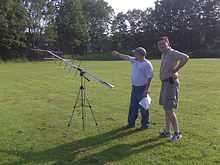Amateur radio satellite


An amateur radio satellite is an artificial satellite built and used by amateur radio operators for use in the amateur radio satellite service.
History
The first amateur radio satellite was OSCAR-1, launched on December 12, 1961, in the United States.
Other programs besides OSCAR have included Iskra (Soviet Union) circa 1982, JAS-1 (Fuji-OSCAR 12) (Japan) in 1986, RS (Soviet Union and Russia), and CubeSats. (There is a list of major amateur satellites in Japanese Wikipedia).
Hardware
The first amateur satellites contained telemetry beacons. Since 1965, most satellites carry a linear transponder for two-way communications in real time. Some satellites have a bulletin board for store-and-forward digital communications, or a digipeater for direct packet radio connections.
Orbits
Amateur satellites have been launched into low Earth orbits and into highly elliptical orbits.
References
- Martin Davidoff: The Radio Amateur’s Satellite Handbook. The American Radio Relay League, Newington, ISBN 978-0-87259-658-0.
External links
| Wikimedia Commons has media related to Amateur radio satellites. |